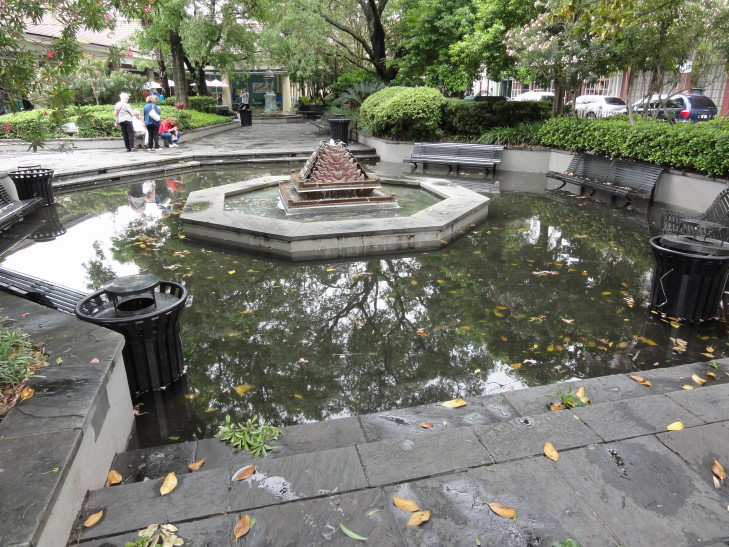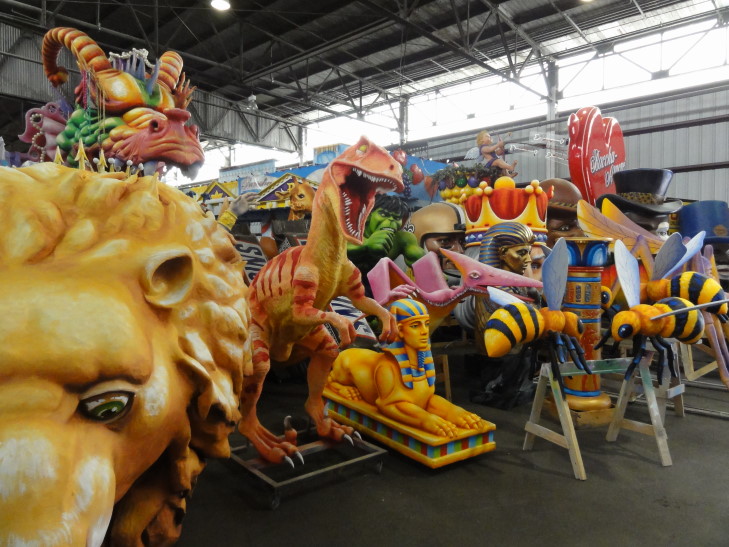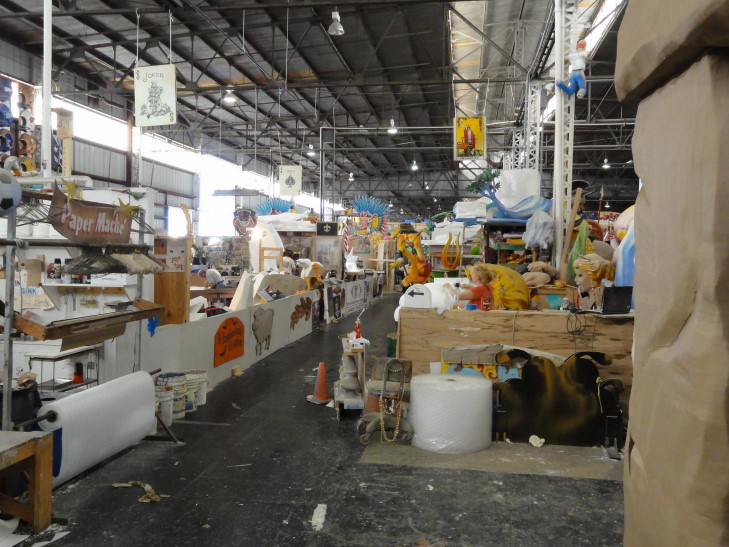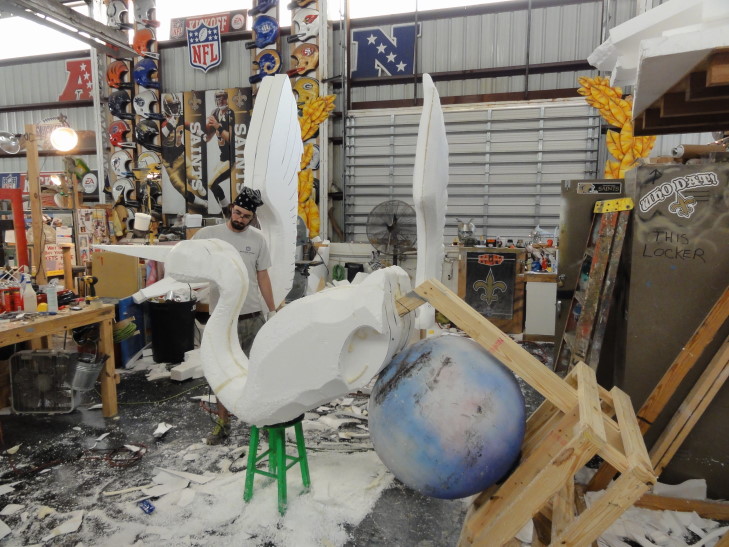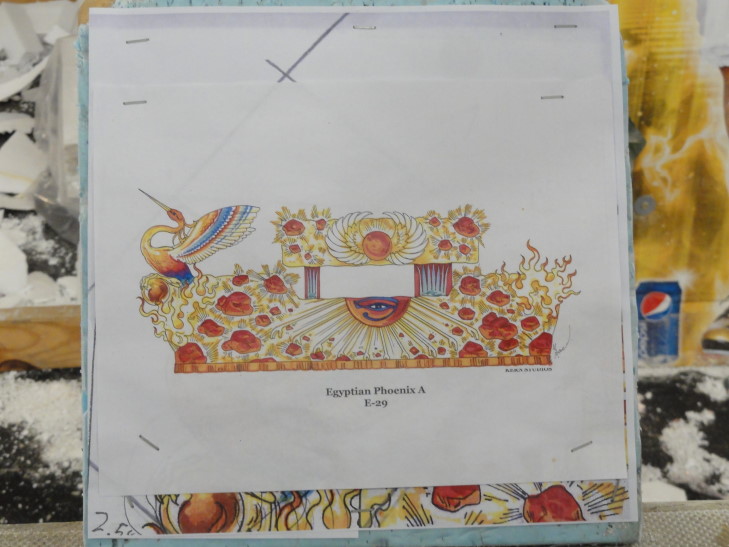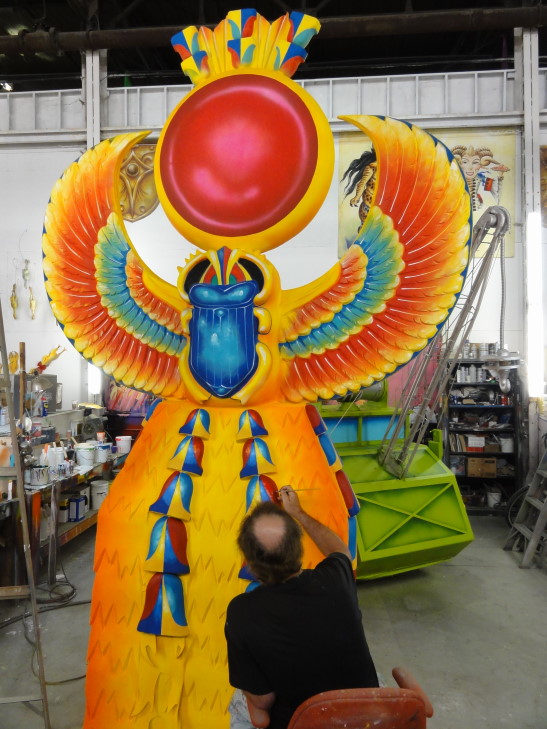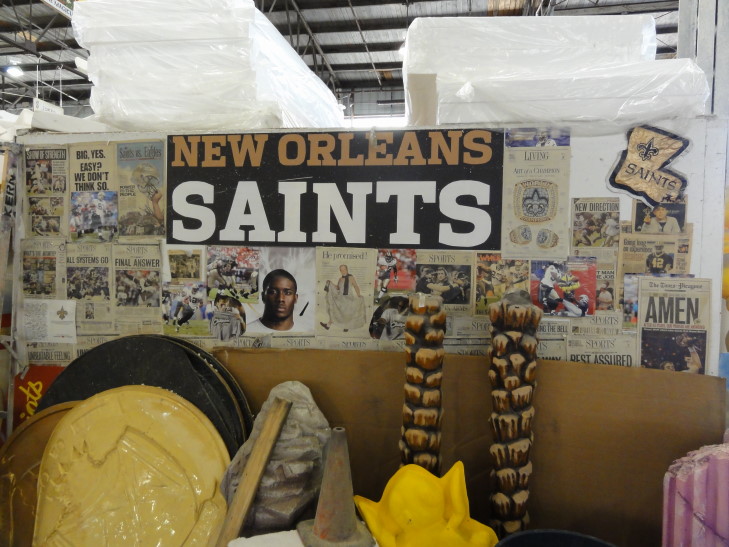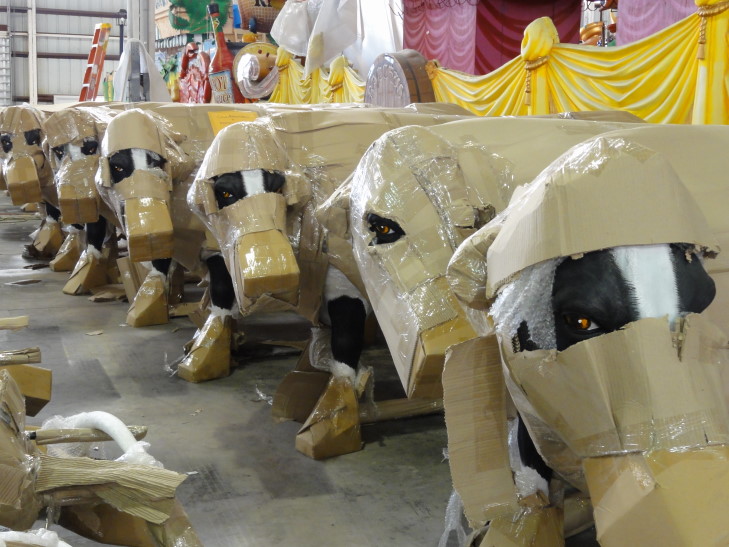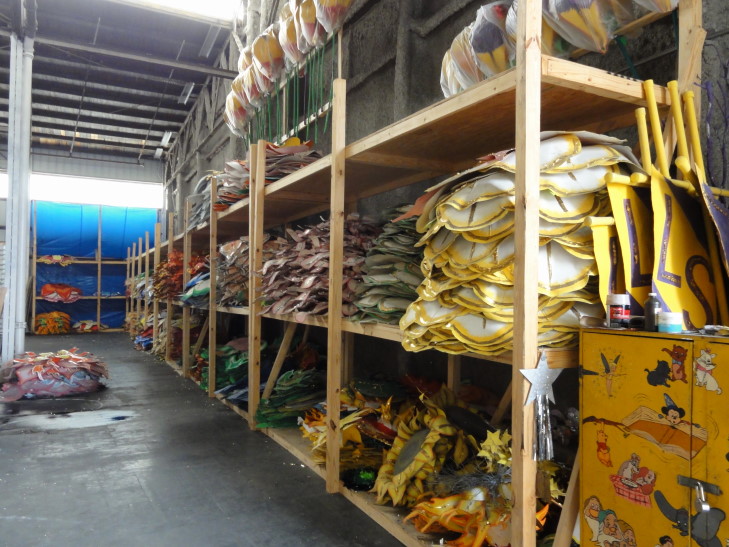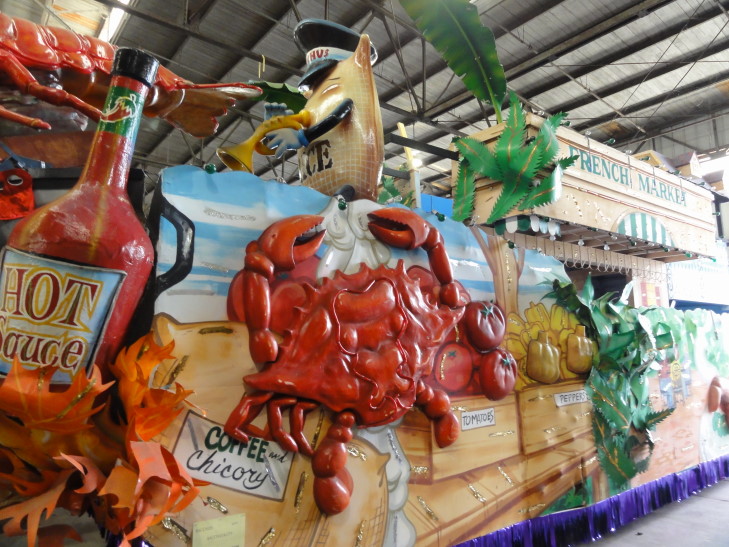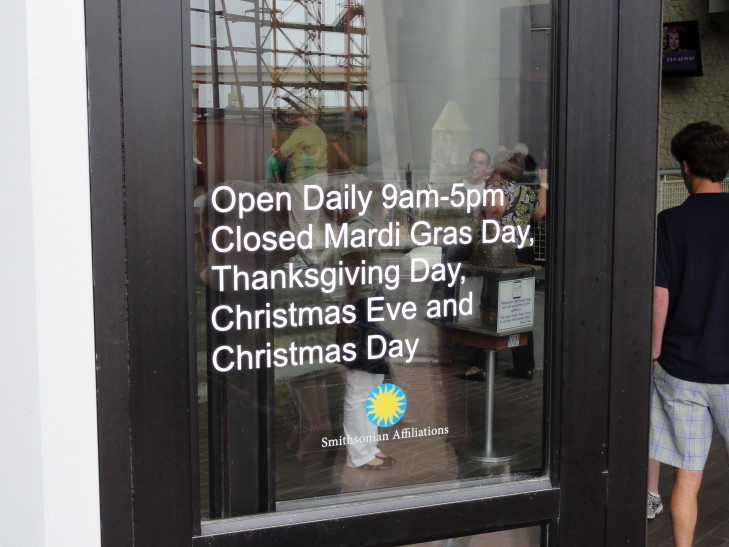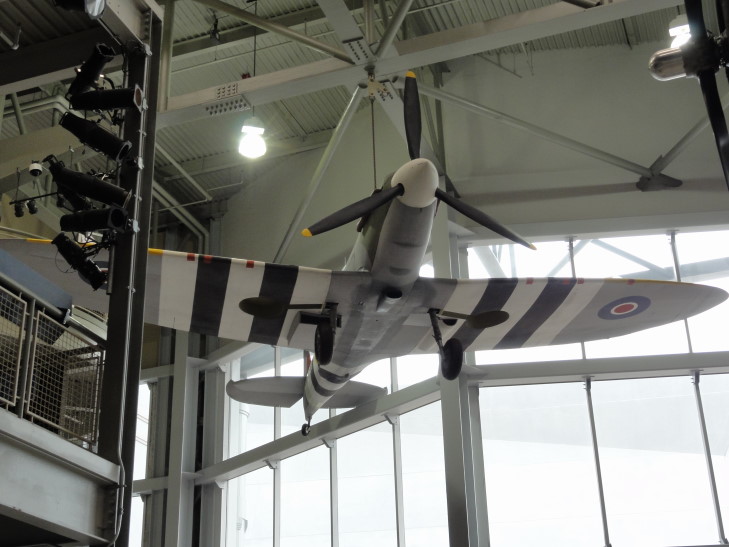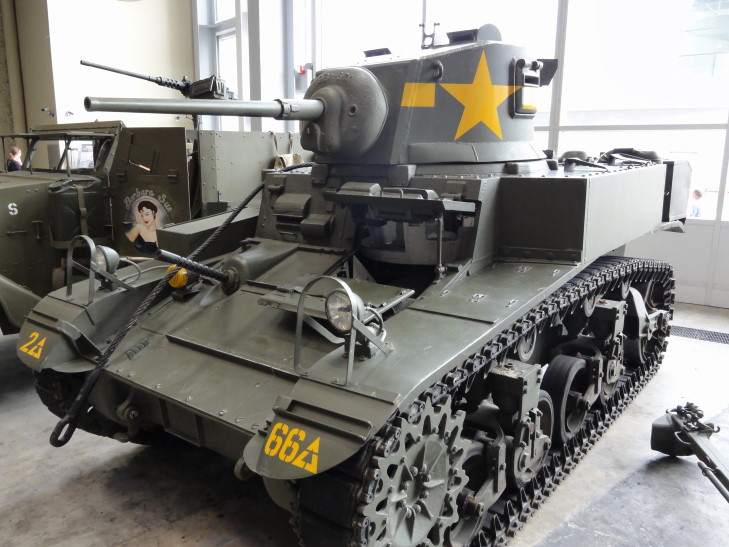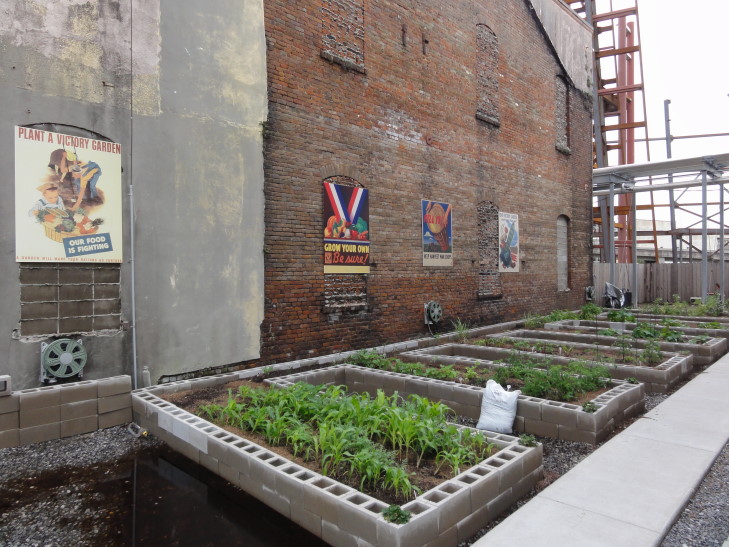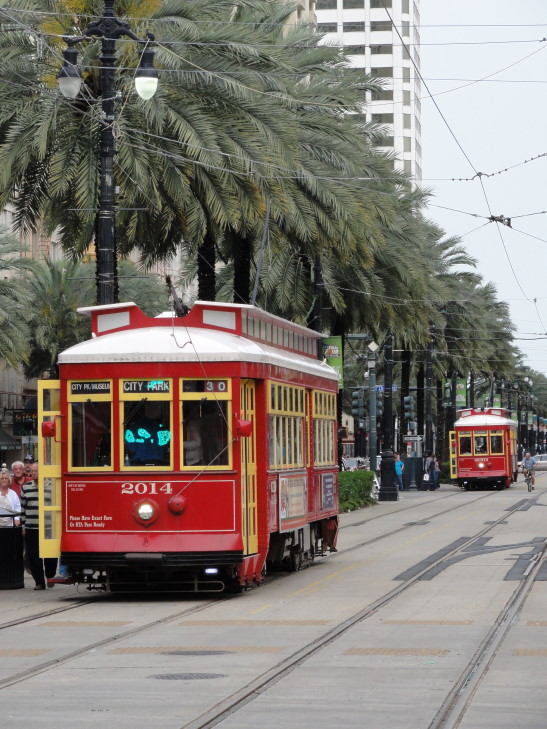Happy Birthday Adrianne!
Due to the thunderstorms that rumbled throughout the night and well into the morning we didn’t get out of bed until super late, about 11a. Met my parents downstairs and we all headed to Croissant d’Or on Ursuline. This time they were open, rejoice! I had a yummy breakfast pastry with ham and cheese in it as well as a blueberry croissant. Dad had two ham and cheese pastries.
Breakfast concluded, Mom and Dad went their own way shopping on Decatur while the rest of us waited for the Riverfront Streetcar to take us towards the Warehouse District where Mardi Gras World had moved (having previously been across the river in Algiers). We had a very nice driver who informed us that we’d be better off going back to Canal (we had ridden all the way to almost the end) and catching the shuttle to Mardi Gras World. Once there we called the shuttle, it appeared in five minutes as if by magic.
After a short ride we were let off in front of a large warehouse. Inside was filled with all manner of fiberglass and Styrofoam props and beyond that the gift shop where we purchased tickets for the 2p tour. We browsed a bit and also admired the Mardi Gras costumes on display in the meantime. At 2p we were herded into a theater with about fifteen or so people and watched a 15 minute video about the history of Mardi Gras and of Blaine Kern, the founder of Mardi Gras World.
Mardi Gras parades started in the mid-1800s and the first krewes, organizations that collected dues from their members to pay for a private ball followed by a public parade, emerged in the 1850s with Comus being the first. Other krewes followed such as Rex and Zulu. In the 1940s Blaine Kern started making props and floats for the krewes, his studio eventually working on 90% of the New Orleans Mardi Gras floats. He also helped form the first super krewe in the 1960s — super krewes having a much more open membership and being led by a grand marshal.
There are 54 parades during the 11 days prior to and including Mardi Gras. They have different routes and different themes and are not connected. Each krewe or organization only parades once. Members, who pay hundreds to thousands of dollars a year to join, are also responsible for buying the Mardi Gras throws — beads, cups, doubloons — which also can run hundreds to thousands of dollars. A particularly prized throw is given out by Zulu — a coconut. Though they don’t throw it but rather hand it out for fear of knocking out spectators!
A parade can have as few as 14 floats or as many as 28 floats, though a float can be a collection of floats strung together and pulled by a single motor vehicle. By law those tossing throws must be masked. In addition, the law stipulates that there be no corporate sponsorship of floats nor advertising on the floats. We also learned that Mardi Gras parades no longer go through the French Quarter as the modern floats are too large for the narrower streets.
After the movie we moved into the warehouse proper where we were given a guided tour. We were able to see Styrofoam props being built by taking multiple 4 foot by 8 foot sheets, gluing them together (and possibly reinforcing them with plywood within), and then cutting them. The lady that was working on one was covered in tiny Styrofoam beads.
More permanent props are made out of fiberglass but cost far more and are harder to modify. Those props would typically be made for a krewe’s signature float — the float that they use year after year. These floats typically have fancy LED lighting, audio-visual equipment, etc. The rest of the floats are typically torn down each year and built to the theme of the following year. They typically use Styrofoam props which can be easily modified. We saw a minotaur that was a soccer player previously but had its head replaced with a bull’s head.
We also saw some props being painted as well as several float designs that had been drafted. It looked like a really creative and fun place to work. It didn’t hurt that there were “shrines” to the New Orleans Saints all over the place.
Every ten years or so a float is brought in and refurbished, sometimes from the chassis on up. After about thirty years they are beyond saving and recycled into new floats. A float costs roughly $50,000 and considering that a krewe needs a minimum of 14 floats to get a parade permit new krewes must often rent floats from Kern Studios at first. We saw the second largest float, a multi-car train. It carried 190 krewe members and even had toilets on board as parades last up to six hours. It was interesting to see that the floats were equipped with hooks to hold the various throws that members tossed out.
One odd part of the tour was seeing row upon row of Chik-fil-A cows shrouded in cardboard and ready to ship out for their billboards — except the eyes. Apparently the eyes had needed inspecting. Made for a spooky picture, at least.
The tour over we were allowed to walk around and take as many pictures as we wanted. In the back of the warehouse there were stacks of decorative flowers to be reused for future floats. They really do try to salvage as much as possible year-to-year. We saw a really cool Louisiana-themed float (complete with crawfish, Tabasco, and beignets) as well as a Halloween-themed one. Prop-wise we saw props for Stitch, lots of cool Egyptian and Greek stuff, Harry Potter on a broom, superheroes, Jungle Book, etc. There was even a Batplane from one of the earlier Batman movies. Kern didn’t make that, however, but rather had bought it. Still was neat to see.
Afterwards we returned to the gift shop and got a free slice of king cake each. It was good, and I got to eat everyone’s icing yum!, but it was hardly free as it left us having to buy overpriced drinks. Oh well, that’s vacation for you. Bought a few beads and a magnet and then headed out.
The shuttle was nice enough to drop us off at the National WWII Museum. Genetta and Addison wanted to visit the gift shop so despite it being 4p we had plenty of time. We went fully through the museum in 2010 and found it fantastic. I did duck into the lobby and check out the progress towards expanding the museum — not just with a building for planes and such but also campaign (Battle of the Bulge, North Africa, Guadalcanal, etc.) specific buildings. The building housing the planes is slotted for completion in 2012 but, as the security guard noted as he pointed to the naked girders springing from the site, it probably isn’t going to make it.
I wandered about the lobby and took some pictures of the most beautiful machine ever built, Britain’s Spitfire, as well as a D-Day landing craft, Jeep (after the war 75% of the Soviet Red Army’s vehicles were American-made as they obtained them through the lend lease program), and the Stuart light tank. The Stuart, while woefully undermanned against the German armor in North Africa, proved to be the perfect tank for the Pacific theater as it was small, fast, and very maneuverable and operated in jungle environments well.
Why New Orleans for the National WWII (and D-Day) museum? Besides being a kick butt city, New Orleans was home to Andrew Higgins, designer of the craft used during the D-Day landings that had the front that opened as a ramp. That craft was central to the strategy outlined by Operation Overlord. Also, in September 1943 92% of all Navy craft in used were designed by Higgins and over half were built in New Orleans by 30,000 workers working in 7 factories.
The kids didn’t find anything they wanted (mostly t-shirts) in the gift shops though I did see (and forget to buy, grrrr) a 45th Infantry pin, the division my grandfather on my mother’s side served with. They fought in North Africa, Sicily, Italy, southern France, and southern Germany. I also saw some Memoir ’44 and Flames of War accessories — they are so neat. I may get Memoir ’44 to play with the kids some day.
We left the museum and went past the reproduction Victory Garden and a fancy restaurant on the museum grounds. Walked to Lee Circle and waited for a streetcar that wasn’t packed to the gills (it took about five or so before we got one, about thirty minutes) to take us back to Canal. We had originally intended to see the Dirty Dozen Brass Band in Lafayette Square but sadly they canceled the concert because of the rain the night before (and the threat of further rain). Once at Canal we traveled to the river and then got the Riverfront Streetcar to Esplanade.
After returning to the unit and resting a bit we met Mom and Dad downstairs and proceeded to Praline Connection. Excellent as always, and again I had the red beans and rice with smoked sausage. Got some cheesecake with praline sauce to go. Yummy! Returned to the unit and watched Psych and then later some of Happy Feet 2 with Addison. A good day!
